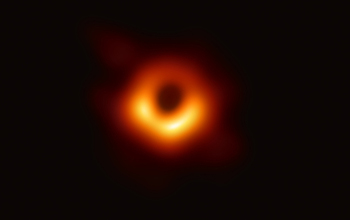Multimedia Gallery
Astronomers capture first image of a black hole
Using the Event Horizon Telescope, a planet-scale array of eight ground-based radio telescopes forged through international collaboration, scientists obtained an image of a black hole at the center of galaxy M87, outlined by emission from hot gas swirling around it under the influence of strong gravity near its event horizon.
More about this image
On April 10, 2019, in coordinated press conferences across the globe, Event Horizon Telescope (EHT) researchers revealed that they have succeeded in capturing an image of a supermassive black hole and its shadow, the first direct visual evidence of their existence.
The image reveals the black hole at the center of Messier 87, a massive galaxy in the nearby Virgo galaxy cluster. This black hole resides 55 million light-years from Earth and has a mass 6.5-billion times that of the sun.
"This is a huge day in astrophysics," said National Science Foundation (NSF) Director France Córdova. "We're seeing the unseeable. Black holes have sparked imaginations for decades. They have exotic properties and are mysterious to us. Yet, with more observations like this one they are yielding their secrets. This is why NSF exists. We enable scientists and engineers to illuminate the unknown, to reveal the subtle and complex majesty of our universe."
NSF played a pivotal role in this discovery by funding individual investigators, interdisciplinary scientific teams and radio astronomy research facilities since the inception of EHT. Over the last two decades, NSF has directly funded more than $28 million in EHT research, the largest commitment of resources for the project.
Read more about this historic announcement in the NSF news release Astronomers capture first image of a black hole. Or learn more about black holes in the NSF Special Report, Exploring black holes. (Date originally posted to NSF Multimedia Gallery: April 10, 2019)
Credit: Event Horizon Telescope collaboration et al.
Images and other media in the National Science Foundation Multimedia Gallery are available for use in print and electronic material by NSF employees, members of the media, university staff, teachers and the general public. All media in the gallery are intended for personal, educational and nonprofit/non-commercial use only.
Images credited to the National Science Foundation, a federal agency, are in the public domain. The images were created by employees of the United States Government as part of their official duties or prepared by contractors as "works for hire" for NSF. You may freely use NSF-credited images and, at your discretion, credit NSF with a "Courtesy: National Science Foundation" notation.
Additional information about general usage can be found in Conditions.
Also Available:
Download the high-resolution JPG version of the image. (1.0 MB)
Use your mouse to right-click (Mac users may need to Ctrl-click) the link above and choose the option that will save the file or target to your computer.

